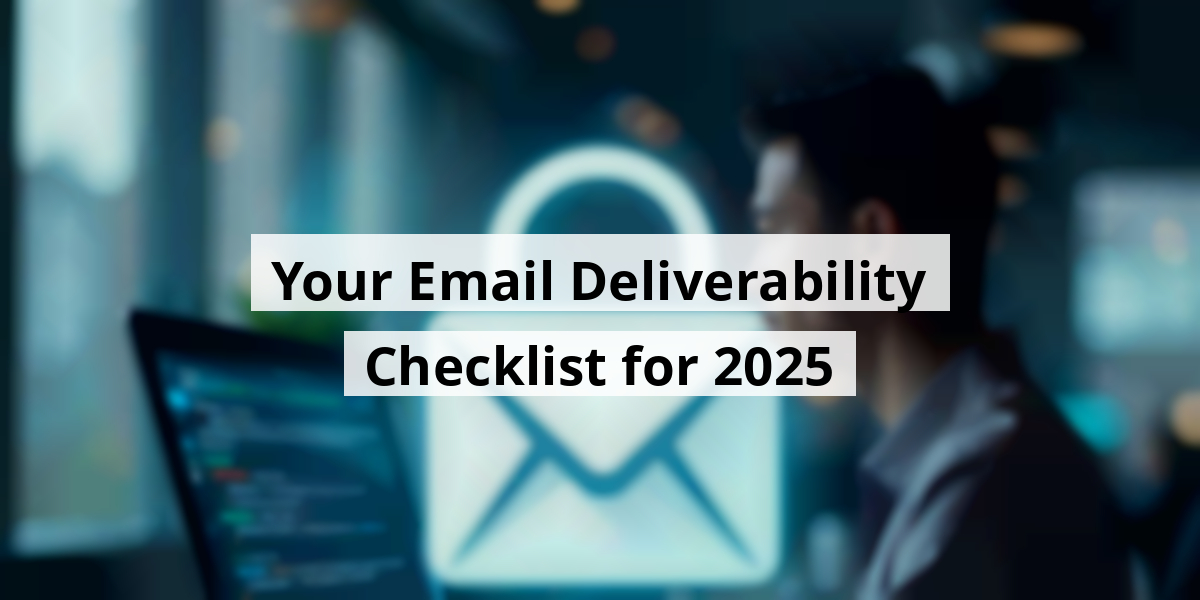 LIMITED SPOTS
All plans are 30% OFF for the first month! with the code WELCOME303
LIMITED SPOTS
All plans are 30% OFF for the first month! with the code WELCOME303

 LIMITED SPOTS
All plans are 30% OFF for the first month! with the code WELCOME303
LIMITED SPOTS
All plans are 30% OFF for the first month! with the code WELCOME303


Now we are going to talk about some essential insights on email deliverability that can turn a lackluster email campaign into a major success. Let’s break it down like a group of friends at a coffee shop discussing the latest trends.
As we continue, we’ll touch on why subject lines and engagement matter like a catchy jingle stuck in our heads.
Now we are going to talk about a topic that cuts to the heart of every marketer's dreams: making sure your emails actually land in inboxes and not lost in some virtual Bermuda Triangle. Let’s unwrap the mystery of getting those emails into the hands of your audience.


Email deliverability is the unsung hero of email marketing — a real VIP pass to your recipient's inbox. You can have the flashiest design and the catchiest subject line, but if your email gets lost in spam limbo, your efforts are like throwing spaghetti against the wall and hoping it sticks. Spoiler alert: it usually doesn't.
So let’s break it down: what’s the deal with email deliverability? We’re talking about a serious business here. It’s not just about sending an email; it’s making sure it lands where it should, like a precision landing in a virtual airport—no turbulence allowed.
Think of email deliverability as ensuring your digital love letters don't get dumped in the spam heap. To make sure your emails are delivered straight to the recipient’s inbox, we have to roll up our sleeves and do a bit of email maintenance. This involves setting up SPF, DKIM, and DMARC records — the Holy Trinity of email authentication. They signal to Email Service Providers (ESPs) that you’re the real deal and not some prankster throwing spam around like confetti at a wedding.
Following best practices for email deliverability can be the difference between your messages being opened or being classified as junk. Nobody wants their hard work going down the proverbial drain.
Here’s where it gets juicy. Email delivery is getting that email to the recipient's mail server—think of it as booking a flight. Email deliverability is ensuring that the email actually makes it to the right gate and gets into the passenger's hands. Got it? It’s vital we grasp this difference because having your emails in the server is one thing, but they need to land in that golden inbox, not float in spam purgatory forever.
Picture this: you’ve crafted the most genius email, but your audience never sees it. Ouch, right? Mastering deliverability ensures that all your creativity and hard work translates into actual engagement. Monitoring your sender score and IP reputation is a little like checking your credit score—it's just something you have to do if you want to keep getting good offers. Tools like MxToolbox and Talos are fantastic for keeping tabs on your reputation in the inbox arena.
Let’s face it, nobody wants their emails to end up in a digital black hole. With a little knowledge and attention, we can make sure our emails spark joy in the inboxes of our recipients!
Now we are going to talk about how to build a strong technical base for nailing email deliverability. After all, like a house of cards, if the foundation wobbles, everything goes down faster than a lead balloon!

Think of SPF, DKIM, and DMARC as your email bodyguards. They work tirelessly to keep your emails safe from phishing attempts and spoofing—sort of like having a bouncer at the door of a club, checking IDs.
To set these up, you simply add records to your email server and DNS settings—don’t fret, it’s easier than assembling IKEA furniture (and fewer leftover screws).
From our experience, emails sent from Google Workspace tend to hit the inbox more reliably than a pizza delivery at midnight. Office 365 is the runner-up in this little race.
If we can send emails using the Google or Microsoft APIs, those emails are more likely to feel personal. Tools like Emelia and MixMax are excellent choices. They help maintain that friendly vibe. Just don’t forget the “please” and “thank you!”
Using a custom tracking domain means you get to keep tabs on how your emails are performing. Think of it as having a remote for the TV—you get to watch the action unfold from the comfort of your couch!
| Step | Task |
|---|---|
| 1 | Create a subdomain. |
| 2 | Configure DNS records. |
| 3 | Set it up with your email service provider. |
Forget about using generic addresses like info@ or hello@! Instead, go for something personal, like john.doe@xyz.com. It feels more genuine, like getting a handwritten letter rather than a stray piece of junk mail.
Employ a solid email warmer to get your emails buzzing with interest. It’s like warming up your vocal cords before karaoke night—necessary to hit those high notes!
Now we are going to talk about some practical tips to keep your email reputation shiny, like a new penny. Sending cold emails? It can be as tricky as herding cats, but with a little finesse, we can make it simpler. Here’s how we can improve our sending reputation while keeping things light and breezy!
It’s a simple formula: fewer emails mean better delivery. Think of it like cooking spaghetti; you wouldn’t pour the whole box into the pot at once, right? Research suggests that sticking to this daily limit helps keep us in the good graces of email providers. It’s all about looking human. Who wouldn’t trust an inbox that sends a reasonable amount of friendly emails each day?
Craving to send more emails? No worries! Just spread your wings a bit. Utilize different domains, like how a chef uses different spices for flavor. Each domain is like a fresh recipe—keeps things interesting and reduces the chances of looking spammy. Plus, it helps avoid the dreaded spam filter. Anyone who's tried to navigate that minefield knows how important it is!
Consistency is key! Even on weekdays, sending emails like a leisurely jog instead of a sprint keeps things smooth. Think of it as a steady drip, not a sudden waterfall. We want to avoid the peaks and valleys that can raise red flags. Aim for a steady pace; after all, nobody enjoys a chaotic email storm!
Nobody likes a surprise blitz of emails—it's like getting a surprise visit from your in-laws. Instead, pace out your sends. A smoother approach over the course of the day reduces blows to deliverability and keeps your audience engaged. A well-timed email is worth a thousand hasty ones!
Ah, follow-ups—the double-edged sword of email marketing. More isn’t always merrier here! Bombarding recipients can lead to more spam complaints, and we sure don’t want that. Sticking to just a couple of follow-ups should do the trick. Give them some space, like a well-meaning friend who knows when to back off. Three days between follow-ups is a good rule to keep the conversation light and engaging.
By keeping these tips in mind, we not only boost our email credibility but also make our digital presence a bit more delightful. So let’s raise a toast to cleaner inboxes and successful outreach! Cheers!
Next, we are going to explore the art of creating top-notch email content that doesn’t just land in the inbox but actually gets opened.


We're all humans, and let's face it, we love a little personal touch in our emails—like when your favorite pizza place remembers your order. Including someone’s name or a nod to their interests makes your emails feel less like a robotic sales pitch and more like a friendly chat.
When we tailor our content to match what recipients care about, it’s like hitting the jackpot in Vegas! Everyone’s more likely to engage, which gives our emails a better chance to soar into the admired “inbox” instead of the dreaded spam folder.
Spam filters are like those overly cautious friends who want to protect you from bad decisions. Using the wrong lingo can send your email straight to the “do not open” list. Ever wonder why you seldom see "free" offers in your inbox? Well, here’s the scoop—words like:
These terms are like waving a red flag to spam filters! Running a quick scan with a good tool can help us dodge these digital landmines.
Subject lines are like first dates; they need to be enticing yet honest. Avoiding overly dramatic phrasing is key. We don’t want to be that person showing up in a tuxedo for a casual pizza night. Instead, a dash of personalization, like adding the recipient’s name, can be that cherry on top!
Preheaders are equally important—think of them as the teaser trailer for your email. They should give just enough info to spark curiosity without revealing everything. This one-two punch can significantly boost open rates.
Who knew that making it easy for folks to unsubscribe would actually help our email game? Seriously, having a buried unsubscribe link is like hiding the exit sign at a medical clinic. It’s a terrible idea! You want to avoid those "this is spam" clicks like it’s your mom’s mystery casserole.
Sometimes, one rogue link can send your email packing to the spam zone. Stick to HTTPS links, and don’t get fancy with link shorteners—those are a one-way ticket to the spam trap. Also, give MailReach a shot to test your links; it’s like having a wise mentor saying, “That one’s no good, skip it!”
Forcing images into your first email can be like bringing a full-blown karaoke machine to a quiet dinner party. They often trigger spam filters or land your message in the promotions tab. Even a logo might not save you this time around. Play it safe until you’ve warmed up the conversation!
No one likes the overly zealous salesperson who won’t take a hint. Crafting emails that read gently, versus those that feel like a tactical siege, can minimize complaints. Keep the tone friendly and light!
Attachments in emails often raise red flags—think phishing vibes. Instead, try using a service like DocSend for sharing documents. It’ll save our emails from looking suspicious. Remember, even if it seems innocent, a random attachment could send our message into the spam abyss.
It’s essential to give our emails a little pre-flight check-up. Using a reliable spam test, like the one offered by MailReach, can be a lifesaver. Getting a solid score keeps our emails sailing into inboxes rather than being tossed into digital oblivion!
In the next section, we will be exploring how keeping a polished email list can make all the difference in our email marketing efforts. A pristine list is like a well-tended garden; it flourishes with care! Let’s chat about some hands-on strategies that pack a punch.
We can't stress enough how important it is to tidy up that email list. Think of it like spring cleaning—nobody wants to constantly stumble over that pile of old clothes, right? By regularly checking for dead weight (or, let’s say, dead emails), we can boost our email deliverability. Keep that bounce rate below 5%. If a friend keeps ignoring your texts, maybe it's time to move on. The same goes for email addresses; never buy lists filled with unverified addresses. Trust us, it doesn’t end well!
If you're working in the B2B space, consider LinkedIn your secret weapon. It’s a treasure trove of connections just waiting to be made. It's like finding the right key for an old lock. Tools like Apollo.io or Evaboot can dig up those elusive emails faster than you can say "networking." Just make sure you're connecting genuinely, not just collecting contacts like Pokémon cards!
Now, let’s talk about segmentation. It’s like sorting your sock drawer—nobody enjoys mismatched socks, and you probably don’t want to send offering emails to recipients who only want to hear about discounts. By breaking your list into smaller, more targeted groups, we can tailor our messages, increasing those open rates and click-throughs. Think of testing different approaches like mixing flavors to find your new favorite ice cream. Who knew chocolate and chili could be a match?
Encouraging engagement is like inviting friends over for a party—no one wants to be the last person dancing alone! Crafting compelling content, snappy subject lines, and personal touches makes your emails feel like handwritten letters rather than spammy junk. Consider using polls or fun quizzes. Everyone loves a little interaction! And when that engagement starts flowing, email deliverability does a happy dance.
Here's a tip: nip those mistakes in the bud! Nobody wants to read “Hi Doe” instead of “Hi John.” We all know those mix-ups can send our credibility tumbling. So, do the necessary checks and ensure answers are in their right place. It may seem trivial, but even the small stuff—like correcting name errors—can make a striking difference. After all, no one wants to be known as the clumsy friend who forgets everyone’s birthday!
So there you have it! Let’s keep that email list polished and watch our marketing efforts bloom.
Now, we are going to talk about the importance of keeping an eye on our sender reputation. It’s like keeping a scorecard for your email campaigns. A good reputation can mean the difference between success and landing in the dreaded spam folder. Let's break this down into strategies that’ll help us boost our sender image.

Your sender score is like your email's GPA. Think of it as a numerical badge that tells the world how trustworthy your emails are. Low scores? Not great—like showing up to a party with last week's leftovers. To check this score, we can use handy sites like SenderScore.org. They provide insights that can help us tweak our strategy and improve deliverability. Watching our sender score closely isn’t just good practice; it’s essential for the success of our campaigns.
Spam complaints can feel like that annoying friend who crashes the party and eats all the chips. To keep your emails out of that spam folder, make them relevant and engaging. Here are a few tips:
Managing bounce rates and unsubscribes? Think of it like tending a garden. Where weeds (or bad emails) grow, flowers struggle to thrive. To keep everything blooming, we should:
Implementing these actions can reduce those pesky bounces and unsubscribes, keeping our sender reputation flourishing.
| Strategy | Action Item |
|---|---|
| Check Sender Score | Use tools like SenderScore.org |
| Minimize Spam Complaints | Send targeted, relevant content |
| Manage Bounces & Unsubscribes | Regularly clean your email list |
With these efforts, we can keep our sender reputation stellar. After all, no one wants to be that email that ends up unopened in the abyss of the spam folder. Let’s keep the conversation going! 🎉
Next, we're going to discuss some neat strategies to give your email campaigns a little extra oomph. Think of these as the spices in your favorite dish—without them, everything feels a bit bland, right?


Turning your email campaigns from “meh” to marvelous is key if we want our messages to actually land in inboxes, not the dreaded spam folder. Who hasn’t felt that sinking feeling when you realize your carefully crafted email is unnecessarily entangled in the digital Bermuda Triangle?
So, let’s explore some strategies that can make email campaigns not just good, but potentially great!
Ever tried out two movie trailers and decided which one got your friends more excited? That’s sort of what A/B testing is for email campaigns! We can pit two versions of an email against each other—maybe one with a quirky subject line and another that’s all business. After running our tests, we’ll say, “Aha! The one with the cat GIF won!” and adapt our approach based on those insights. It's like flipping a coin for your next pizza order but with way more at stake.
Regularly tweaking those details can mean the difference between clicks and crickets, leading to emails that not only look good but also work hard.
Now, let’s chat about metrics. Oh, the joy—and occasional dread—of numbers! We’ve all been there, staring at our open rates as they tumble like a teenager's first crush. But don’t let that discourage you. Metrics like open rate and click-through rate are our compass. They guide us to figure out what’s hitting the mark and what’s better off left in the drafts folder. By carefully evaluating our data, we can say goodbye to guesswork and hello to precision!
There’s no shame in needing a little help. Email deliverability tools are our trusty sidekicks, ensuring our emails don’t end up lost in cyberspace. These tools help us with things like:
With tools like GlockApps or Sender Score in our toolkit, we can boost our chances of landing where we intend to—right in the inbox of those we want to reach. Think of them as the trusty GPS for our email adventures!
In summary, testing, monitoring, and using the right tools can transform the way we connect through email, leading to campaigns that not only resonate but also make a genuine impact. So, let’s roll up our sleeves and see what magic we can whip up in our next email blast!
Now we are going to talk about the importance of warming up new domains and IP addresses for email deliverability. You might think it sounds boring, but trust us, it’s like rising dough—it needs its time or it just won’t rise! So let’s roll up our sleeves and get into why this matters and how to do it effectively.
Starting your email sending with a trickle instead of a flood is key. Think of it as training for a marathon. Would we just jump out of bed one day and run 26 miles? No way! We begin slowly, building endurance. For email, start with a small volume — a handful of emails per day, gradually ramping up. You wouldn’t want your shiny new domain to be flagged as spam on day one. Instead, give it time to build that rapport with email service providers. It's like showing up to a party and gradually mingling rather than just shouting from the roof about how great you are!
Have some folks in your contact list who’ve engaged with your emails before? Now’s the time to reach out! Engaging with these friendly faces helps signal to service providers that we’re not some random spammers. By showing that our emails are relevant and valuable, we're like that great stand-up comic who keeps getting more hecklers because everyone wants a little more of the fun! Make sure to keep an eye on those engagement metrics, although they can sometimes feel like a rollercoaster ride. Up and down, up and down. If things start slipping, it’s a good time to hit pause and reassess our game plan!
Staying in tune with our email performance isn't just smart, it’s essential. Like regularly checking the oil in our car, we track those crucial metrics such as open rates, click-through rates, and yes, even spam complaints. If our emails are falling flat, it’s our cue to pivot and adjust those tactics. No one wants to be the last person still doing the Macarena at a party—it's time to switch things up when needed! By consistently monitoring our performance, we can uncover the secrets (well, more like visible clues) to refining our approach and improving deliverability. In the email game, knowing when to adapt is what keeps us ahead of the curve. Plus, let’s be real, wave after wave of failure might just make the inbox worse for everyone involved.
With these tips, we’re not just flying by the seat of our pants—we're setting ourselves up for email success from the get-go!
Next, we’re going to talk about the essential need to stick to email regulations that keep our sending reputation squeaky clean. It's a bit like maintaining your car—ignore the basics, and you'll end up stuck on the side of the road. Let’s roll up our sleeves and explore some key regulations and best practices, shall we?

We can't emphasize enough how crucial it is to know your way around email regulations like the CAN-SPAM Act and GDPR. Imagine showing up to a party and realizing you forgot the snacks—awkward, right? Well, non-compliance can lead to hefty fines and a whole lot of unwanted attention.
Here’s the scoop: the CAN-SPAM Act and the GDPR are like the superhero duo of email marketing regulations. They swoop in to keep your campaigns legit—and honestly, it’s a bit of a buzzkill if you don’t follow their rules.
Ignoring these regulations is like stepping into a lion’s den wearing a steak suit. We recommend being upfront with your audience, or you might just lose their interest—and their trust.
Now, let’s chat about double opt-in and how it’s basically the bread and butter of consent in email marketing. Picture it as having a bouncer at your club—only those who are serious about getting in are allowed. This process ensures your audience genuinely wants in, leading to fewer spam reports.
Buckling down on this can help maintain a solid relationship with your subscribers. And here’s the kicker—always offer a straightforward unsubscribe option. This isn’t just good manners; it complies with regulations. We like to think it’s a graceful way to let people down, like saying, “Hey, it's not you, it's my inbox.”
| Regulation | Key Requirements | Consequences of Non-Compliance |
|---|---|---|
| CAN-SPAM | Include a physical address, no misleading subject lines | Fines up to $43,792 per violation |
| GDPR | Explicit opt-in, data protection measures | Fines up to 4% of annual global turnover |
| CCPA | Transparency in data collection and usage | Fines up to $2,500 per violation |
Incorporating these strategies isn’t just about compliance. It’s about building a trustworthy relationship with your audience while keeping your email game strong. After all, wouldn’t we all rather spend our time crafting fabulous emails than navigating a legal minefield? Absolutely!
Now we are going to talk about the importance of email deliverability. It's like trying to send a love letter but getting it lost in the Bermuda Triangle of the internet. Let’s explore what we need to do to get those emails right where they belong—in our subscribers’ inboxes!


Now we are going to talk about how we can keep our emails on the friendly side of the inbox, away from the lurking spam folder. It's like trying to make a good first impression at a party—you want to look your best and not be shoved behind a potted plant!
To check mail deliverability, several helpful tools come to our rescue, almost like the superhero squad for our inboxes. Think of Mailtrap Email Testing, Mail-tester.com, GlockApps, and SendForensics. Sending test messages using these platforms is like getting your email a thorough spa day. They're going to evaluate every little thing and tell you if you pass the spam filter's judgement.
And guess what? We even get insights from SpamAssassin, that well-known spam checker created by the clever folks at the Apache Software Foundation. Who knew we were fighting spam with such style?
Email deliverability isn't just a roll of the dice; there are metrics we should pay attention to, sort of like keeping score at a game night. Here are the big players:
Keeping these metrics healthy is like maintaining a good diet; it helps our emails reach the intended inboxes every time!
Several factors play a crucial role in whether our emails strut right into the inbox or end up as spam. Here’s what we should be mindful of:
Email deliverability tools are our trusty allies, armed with features that help ensure our messages land where intended. Imagine them as the traffic lights controlling the flow of our emails. They help monitor our campaigns, track delivery rates, and alert us about potential problems that could lead to disaster—like being marked as spam! Features like automated bounce handling and blacklist monitoring are just a few tricks of their trade.
Finally, let’s clear up the difference between email delivery and email deliverability. Email delivery just means that our email made it to the recipient's mail server, while email deliverability means it successfully got cozy in their inbox. It’s like sending an invitation versus actually getting someone to RSVP—let’s aim for the RSVP every time!

